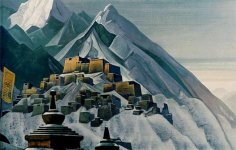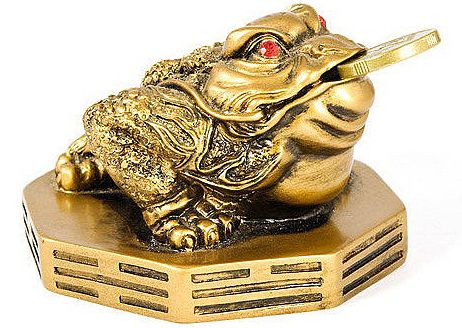
The legend of the mysterious land of Shambhala holds great significance in Buddhism due to its connections to the future. It is prophesied that the warriors of Shambhala will win the final battle against the forces of ignorance and evil on Earth, after which Maitreya, the Buddha of the future, will appear on our planet from the Pure Land of Tushita, and the Kalachakra teaching will be established across the planet.
To this day, many scholars and researchers are intrigued by the history of this mysterious land, accessible only to those enlightened in soul and thought, and whose location remains a mystery. References to this enigmatic land can be found not only in the scholarly research of orientalists, but also in the diaries of ancient travelers, ancient Tibetan Buddhist books, and theosophical works. Shambhala is the subject of much debate among mystics, written about by researchers, and discussed by religious figures.
There are many descriptions and definitions of Shambhala. According to some scholars, Shambhala is the most sacred word in Asia, as it embodies all the best human aspirations and expectations. It is not only a place, but also a teaching and an era. The Encyclopedia of Mystical Terms offers a different definition: Shambhala is a mythical land located north of the Sita River and surrounded by eight snow-capped mountains resembling lotus petals. This land is ruled by priest-kings. Shambhala is the center of the mystical teaching known as Kalachakra and, apparently, the mystical, secret center of the world. Folk legends of the Himalayas and Tibet speak of Shambhala as a kind of planetary paradise, inhabited by Great Masters or Mahatmas, who guide the destiny of humanity.
Sacred texts state that the kingdom of Shambhala will, if necessary, establish contact with our world. In his book “Paths to Shambhala,” the author, the 6th Panchen Lama, asserts that Shambhala is simultaneously three completely distinct things: a real physical place, a symbol of achieving enlightenment in yoga, and a pure land. That is, on one level, Shambhala is an ordinary country inhabited by ordinary people; on another, it is a pure land, with whose representatives only those with pure karma can establish contact. If the necessary conditions are created, mystical heroes from this land will appear and help defeat evil forces.
There is also a belief that Tibetans imagine Shambhala as the abode of gods, that is, superhumans endowed with certain knowledge and magical powers. Apparently, these beliefs led Europeans to perceive Tibet as the abode of immortal sages who guard all the secrets of the world.
Numerous written sources refer to Shambhala as the land of immortals, a forbidden territory in the center of the Gobi, a kingdom of magicians, a well-organized community of sages in the heart of Asia, a land of Great Masters, a world of harmony and perfection where all dreams come true, the hidden center of the world, an abode of light, a lost paradise on earth, an oasis of comic culture, and the legacy of vanished civilizations.
Tibetan religious records contain a detailed description of Shambhala. This mysterious land is divided into eight parts, like a lotus flower, and surrounded by mountains of ice. The kingdom's capital, the mystical Kalapa, is located in the center. To the west and east of the city are two crescent-shaped lakes filled with jewels. To the south of the capital is a sandalwood park, and to the north are sacred idols and altars. The ruler's palace, built of precious stones, metals, and coral, is also located there. Its roof is made of gold, adorned with pearls, sapphires, emeralds, and diamonds. To regulate the temperature, special crystals are embedded in the floor and ceiling. In the center of the palace is the ruler's golden throne, also adorned with precious stones. The king possesses a magical gemstone that will grant all wishes. The king has a glittering retinue, always ready to carry out his commands. He also has elephants, horses, and other means of transportation, including a flying machine made of stone. His reserves of jewels and gold are enormous.
The people of Shambhala live in peace and harmony, free from hunger and disease. They are all beautiful and wealthy, but they have nowhere to spend their wealth. They are not immortal, although they live for about a hundred years, devoting their lives entirely to achieving enlightenment.
Shambhala, like Atlantis, is considered a state where, in addition to an extremely high level of spiritual development, all manner of technologies and sciences were developed. There are also descriptions of magical lenses installed on palace roofs, allowing residents to explore other worlds. There are also stories of cars and planes traveling through tunnels. The king possesses a mirror with which he observes events in distant locations. There are descriptions of stone horses possessing the power of the wind and technologies capable of transforming one chemical substance into another. Furthermore, spiritual development is so advanced that people practice telepathy, telekinesis, materialization, and dematerialization.
The land of Shambhala is guarded by supernatural forces and beings. These guardians are generally invisible, but some sources contain accounts of people who have encountered them. Incidentally, one of these guardians is believed to be the Yeti, or Snowman, who was recently actively sought in the Himalayas. However, more often, this description boils down to this: the guardians have a perfectly calm face, with an open gaze fixed on some invisible object. This creature moves by jumping, like a ball.
Archaeologists have failed to find any material evidence that Shambhala actually existed in the past, so it is impossible to determine the exact location and identify this mystical kingdom.
The Mahabharata, an ancient Indian epic, mentions a village called Shambhala, where the twice-born Kalika will appear. According to Tibetologists, Shambhala is a real country located northwest or north of India.
Many descriptions of Shambhala emphasize that it is located among very high mountains north of India and west of China and Mongolia, in other words, in an area that coincides with Tibet. Historical Tibetan chronicles also mention Shambhala, which is located north of India. They also say that the road to this country is very difficult and long, requiring more than four months' journey from the Ganges.
There is also a mention of Shambhala in the Tibetan Buddhist books “Danjur” and “Ganjur.” They describe the country as being divided into three regions, and its inhabitants wear turbans and white robes and speak Sanskrit.
In Europe, the first mentions of Shambhala appeared in 1627 in letters by Jesuit missionaries John Cabral and Stephen Casella. While in Bhutan, they learned of a country called Shambhala, located somewhere in the northwest or north and bordering Tartary (i.e., Russia). This reference later led to the assumption that Shambhala could be located in the territory of the former USSR, in Central Asia.
The Tibetan scholar Manjul Khutuktu, who lived in the first half of the nineteenth century, wrote in his geographical study that the famous kingdom was located far to the north and consisted of 96 kingdoms. Of course, it's impossible to find associations between the names cited in the work and modern country names, but the ninety-headed Mongol-Tatar horde, described in one of the Tatar epics, whose borders extended as far as Turkestan, comes to mind.
The legend of Shambhala has been repeatedly used in politics, particularly when seeking military or political support. Russia, Japan, and Mongolia were particularly associated with Shambhala. It is also known that Nazi Germany sent members of the Ahnenerbe organization on expeditions to Tibet in order to acquire the secrets of Shambhala, which would aid in the Nazis' master war plan. Hitler was attracted to the idea of a superior race endowed with supernatural abilities and great powers. Therefore, from 1931 to 1943, numerous expeditions were sent to Tibet. The Nazis were confident that they would be the ones to conclude a treaty with Shambhala and become masters of the planet, and Hitler himself was absolutely certain of his own chosenness. In his view, Shambhala was a city of power and violence, controlling human destinies. But to conclude such a treaty, a sacrifice was necessary. It was for this reason that millions of Jews and more than half a million Roma were shot.
Be that as it may, it's clear that the legend of Shambhala remains just that—a legend. And it differs little from other similar myths about an ideal state, found in the tales of all peoples. Ultimately, the dream of an ideal society is entirely human, as few would likely refuse to live happily ever after, free of wars and epidemics, for many years. Beyond its purely practical side, this legend also has a spiritual component, representing an ideal model of human life striving for ultimate liberation. It embodies the wisdom of the warrior, a tradition of fearlessness and bravery. The teachings of Shambhala suggest that in the face of numerous global problems, humanity must be both heroic and kind. It touches everyone and compels us to consider what each of us can do to help this world become a better and cleaner place.





